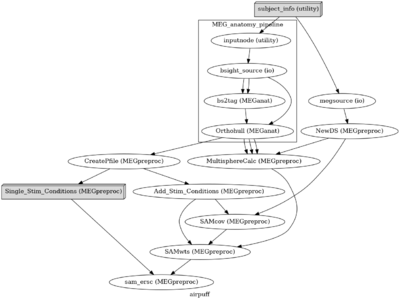Meg analysis pipeline: Difference between revisions
(Initial) |
(→Nipype) |
||
| Line 8: | Line 8: | ||
===Nipype=== |
===Nipype=== |
||
[https://nipype.readthedocs.io/en/latest/ Nipype Pipeline Toolbox] |
[https://nipype.readthedocs.io/en/latest/ Nipype Pipeline Toolbox] |
||
[[File:Nipype pipeline.png|center | 400px]] |
|||
===Git=== |
===Git=== |
||
Revision as of 11:24, 21 August 2020
Reproducible MEG Analysis
MEG data collection and analysis requires a lot of interacting components (Stimulus delivery, logfiles, projector onset triggers, analog and digital triggering, electrophysiology measures, MRI coregistration...) that can lead to heterogeneous data and data quality. This makes pipeline analysis particularly difficult due to the variability in inputs. Additionally, with the multitude of techniques and metrics to evaluate MEG data (dipole/MNE/dSPM/beamformer/DICS beamformer/parametric stats/non-parametric stats ....) projects can have evolving analysis protocols. Knowing what preprocessing was performed on what datasets can often come down to an excel spreadsheet or text document. Since these projects can sometimes last multiple years, it is important to know what was done to produce a specific result and how to apply these analysis techniques to new incoming data.
Containerized Computing Environment
Nipype
